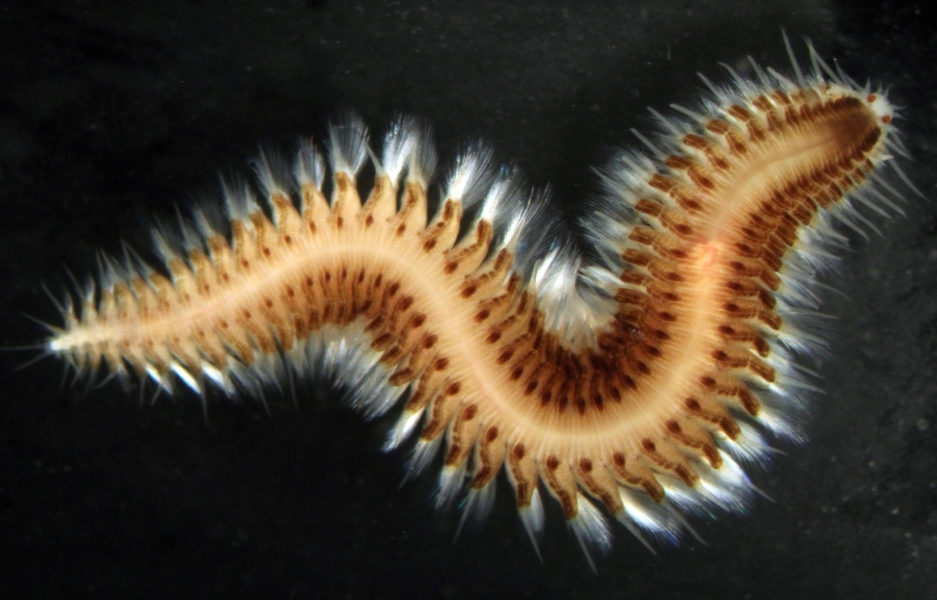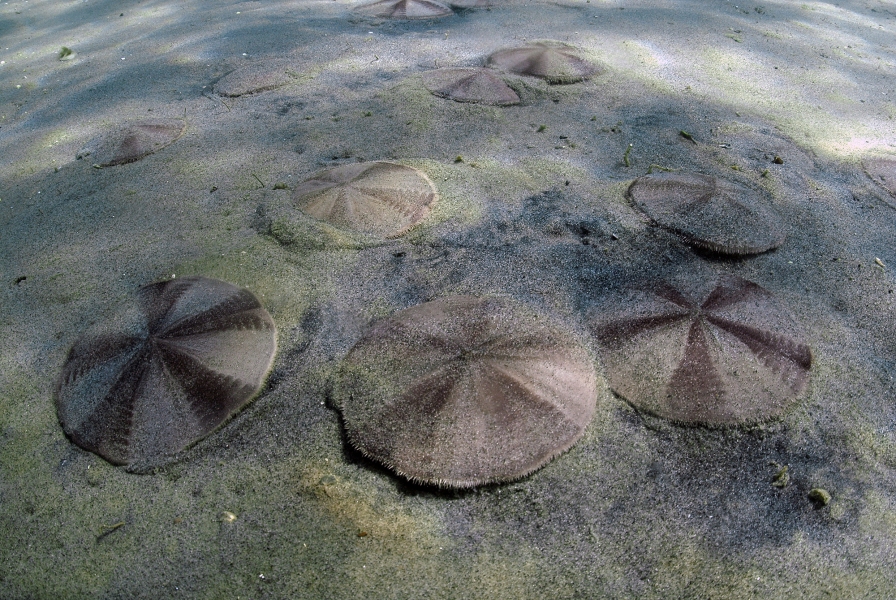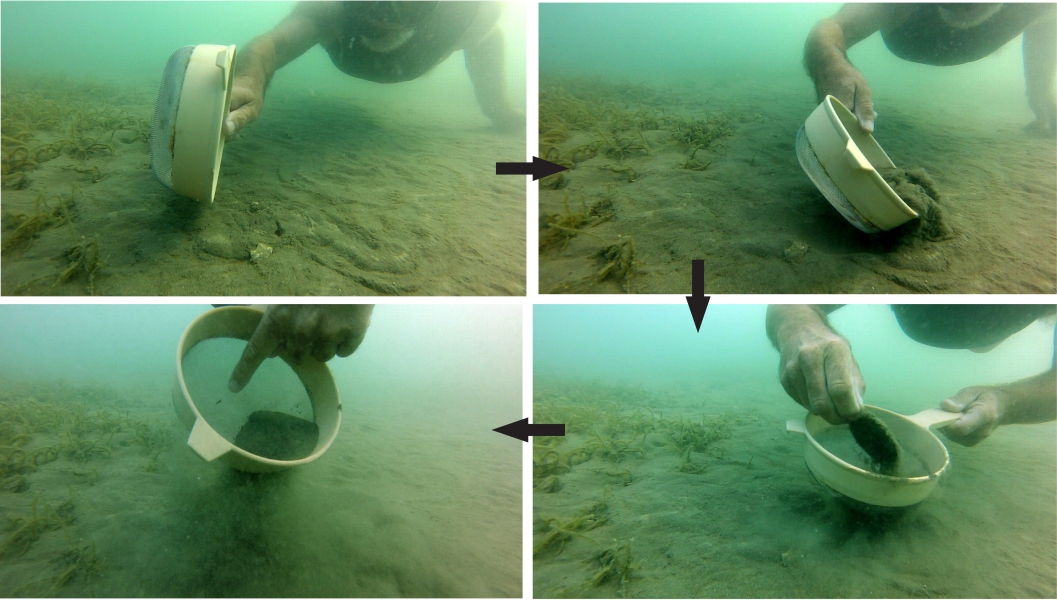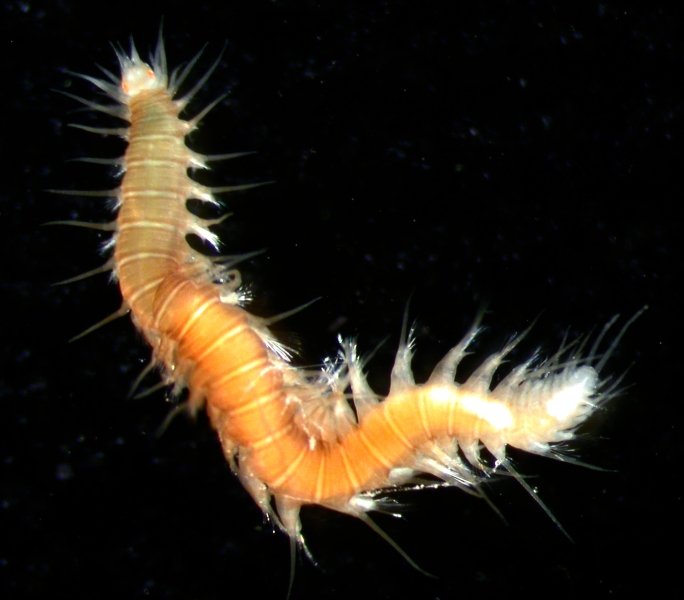Hesionids are lively compact small worms, often richly coloured and with a good set of eyes (2 pairs, with lenses). They are carnivorous, swift-moving and alert, and readily take to the water to swim away when disturbed. Usually they live hidden on objects, not crawling free on the sea bottom or burrowing into sediment.
The family has several species which adopt other much larger marine organisms for a convenient place of safe residence, in either permanent (obligate) or casual (facultative) commensalisms. The best known hesionid with this habit is the North Pacific Oxydromus pugettensis, a facultative commensal with seastars (1), but other hesionids have been found living on or with various other echinoderms (which are the most popular hosts), or as associates of crustaceans, molluscs, and large burrowing worms (2).
See Oxydromus pugettensis and some colourful hesionid relatives on Flickr
No commensal relationship had yet been found in New Zealand, but Northland marine biologist Dr Roger Grace became curious when a little polychaete kept turning up whenever his Kaipara Harbour bottom samples included large numbers of the coastal sand-dollar urchin Fellaster zelandiae. An adult New Zealand sand-dollar is about 80 mm diameter and occurs just buried in sand, intertidally as well as subtidally, in big shallow harbours and also in open coast surf zones. So did the sand-dollar have a polychaete 'friend' and could this association be as close as a commensalism?
Exposing the hesionid in New Zealand
Together with Geoff Read, our NIWA polychaete expert, Roger began by looking at sand-dollar urchins on beaches, and found the same little brown hesionid worm (photo) actually living underneath them. By scooping under an urchin with a small sieve this agile worm can be captured before escaping (photos). They have found the hesionid living under Fellaster zelandiae intertidally or in the shallow subtidal at a number of places in the northern North Island, present under up to 44% of larger urchins, with usually just one per urchin, but sometimes with up to five worms observed together. The wider distribution of the hesionid is unknown at present, but the host sand-dollar urchins occur throughout the North and South Islands of New Zealand.
The behaviour of the Fellaster hesionid with its host under natural conditions is difficult to observe since both are buried in sand out of sight. In aquaria the worms crawl on or under an urchin (photo and video) and appear untroubled by the moving spines and tube feet, or the plier-like pedicellariae tube feet of F. zelandiae, which are too tiny to be offensive weapons against the hesionids. So what is the attraction for the worm? It seems at minimum the hesionid has a preference for sheltering under a convenient sand-dollar 'roof' as a refuge in an otherwise physically challenging environment, but it may have ability beyond that to be a commensal, or even a parasite. This remains to be determined.
The genus Oxydromus
The Fellaster hesionid is a member of genus Oxydromus and appears to be undescribed. It is remarkable it has been overlooked until now. A distribution centered only on the Auckland region raises the possibility the hesionid has been introduced via Auckland port as have other polychaetes, but this seems less likely if the species is a specialist associate of urchins. It differs distinctly from the known local free-living Oxydromus species, O. angustifrons, which is a very common darker brown epifaunal hesionid (photo).Oxydromus is a relatively large genus of over 30 valid species, and many more synonyms, with a long messy but interesting taxonomic history (3, 4), and is probably better known to ecologists under its rival (but junior) synonyms Ophiodromus and Podarke.
The video below shows an Oxydromus sp. investigating a sand-dollar. Here the sand-dollar is temporarily upside down for filming.
References:
(1) Hickok, John F.; Davenport, Demorest. (1957) Further studies in the behavior of commensal polychaetes. Biological Bulletin 113(3): 397-406
(2) Martin, D.; Britayev, T. A. (1998) Symbiotic polychaetes: review of known species. Oceanography and Marine Biology: an Annual Review 36: 217-340
(3) Read, Geoffrey (2014). Oxydromus Grube, 1855. In: Read, G.; Fauchald, K. (Ed.) (2014) World Polychaeta database. Accessed through: Read, G.; Fauchald, K. (Ed.) (2014) World Polychaeta database at http://www.marinespecies.org/polychaeta/aphia.php?p=taxdetails&id=173457
(4) Villalobos-Guerrero, Tulio; Harris, Leslie. (2012) Oxydromus Grube, 1855 reinstated over Ophiodromus Sars, 1862 (Polychaeta, Hesionidae). ZooKeys 241(0): 21-31





